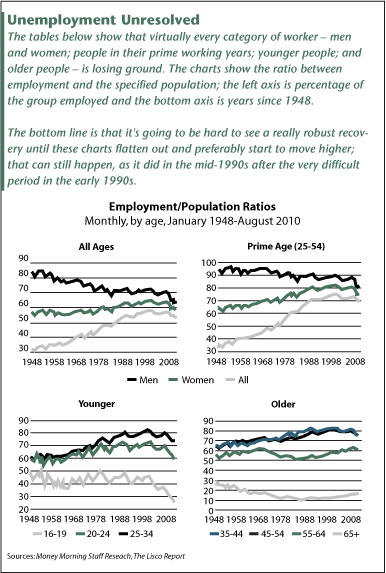There's no getting around the fact that the U.S. jobs market is bleak. Ultimately, though, it's a stark reminder that as investors, we should be looking abroad for maximum profits.
Indeed, investors must turn to countries where the number of people working is rising along with standards of living and consumption.
But that's not all.
There are a few companies that have been performing exceptionally well and are poised to bring investors some joy this holiday season. Before we get to those, though, let's take a quick look at the job market.
A year ago, I said that observing the pace of growth in the real economy - outside of federal help - would be like watching paint dry due to the drag of de-leveraging. That's turned out to be fairly accurate.
Philippa Dunne - an analyst who does really in-depth, state-by-state analysis of employment through the prism of payroll taxes - has a term for what's happening: "improved stagnation." Dunne says that the only real positive right now is that wages are quite good for people with jobs and that the "under-employment" of those who kept their jobs through the recession (people working reduced hours and forgoing bonuses) has been reversed.
Still, if you look at the tables below, which come from The Liscio Report, you'll see that virtually every category of worker - men and women; people in their prime working years; younger people; and older people - is losing ground equally.
The charts show the ratio between employment and the specified population; the left axis is percentage of the group employed and the bottom axis is years since 1948. It's interesting to observe how the number of women employed rose rapidly from the 1950s to 2000s and has slid since; and in the lower right you can see how the number of people working after 65 has risen.
The bottom line is that we won't see a really robust recovery until these charts flatten out and preferably start to move higher - as they did in the mid-1990s after the very difficult period earlier in the decade.

Of course, as ugly as the job picture is there is still some good news.
Chain store sales increased quite a bit in September, with a stronger-than-expected back-to-school season. Same store sales were up 2.6% from a year ago, overall, while Reuters/Thompson reported a 2.8% sales gain in the 28 top retailers it tracks, well ahead of the 2.1% consensus.
Department stores like Macy's Inc. (NYSE: M) and J.C. Penney Co. Inc. (NYSE: JCP) performed well, which shows glimmers of the confidence that needs to emerge.
These figures give investors real hope for a decent holiday shopping season in November and December. The ICSC trade group forecasts a sales increase of 3% to 3.5%, which would be the strongest holiday season on a year-over-year basis since 2006. Two of my major recommendations in this area are toy makers Mattel Inc. (NYSE: MAT) and Hasbro Inc. (NYSE: HAS). Hasbro in particular has been exceptionally well run and an absolute stud all year. In fact, the stock is up fourfold since 2000, and breaking out again now. Both companies should do well through the rest of the year, as even the most financially strapped parents will find a way to buy games and toys for their kids.
Another top recommendation of late is Hansen Natural Corp. (NYSE: HANS), which has risen strong this year amid a robust food and beverage sector. It is one of the most schizophrenic companies I have ever studied. If you look at its website and products page you will see no mention of the carbonated beverage that provides most of its growth: the Monster brand energy drink, whose slogan is "Unleash the beast."
Hansen's Web site is all about wholesome drinks like preservative-free natural sodas and low-calorie peach smoothies; there's a section for energy drinks, but only ones of a pretty tame nature with cute names like Rumba. Nowhere will you find a link to the Monster Hitman Energy Shooter. It's as if the company is a family that keeps this crazy relative in the attic whose sole occupation is to think up ways to turn the nation's chronic sleep deprivation into profits.
Hansen stock slipped in the second quarter this year after its distributors had stockpiled Monster in the last few weeks of 2009 to avoid new sales terms and conditions. But all was forgiven, I guess, when first-half sales were reported at $603.8 million, up from $544.4 million for the same span in 2009. Return on equity was reported at 33.6%, a profitability level that's well above competitors. Drink the Kool-Aid; this is a keeper.
[Editor's Note: Money Morning Contributing Writer Jon D. Markman has a unique view of both the world economy and the global financial markets. With uncertainty the watchword and volatility the norm in today's markets, low-risk/high-profit investments will be tougher than ever to find.
It will take a seasoned guide to uncover those opportunities.
Markman is that guide.
In the face of what's been the toughest market for investors since the Great Depression, it's time to sweep away the uncertainty and eradicate the worry. That's why investors subscribe to Markman's Strategic Advantage newsletter every week: He can see opportunity when other investors are blinded by worry.
Subscribe to Strategic Advantage and hire Markman to be your guide. For more information, please click here.]
News and Related Story Links:
- Money Morning:
Hot Stocks: How the “Beta Chase" Could Spark a Major Breakout for Exxon - Money Morning:
The Fed's Actions Are Boosting the Bull Cycle for U.S. Stocks - Money Morning:
Seven Ways to Profit From the Worldwide Currency War - Money Morning:
Will the Fed's Spending Drive Stocks Back Up to Their Pre-Lehman Levels? - Money Morning:
Four Emerging Markets Making Waves Around the World - Money Morning:
Don't Miss Out on the Global Stock Rally


